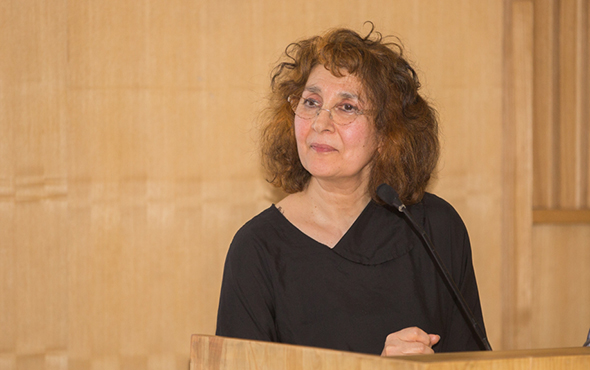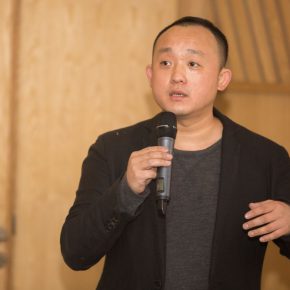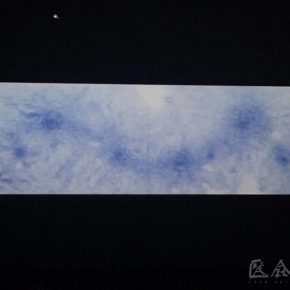
On the evening of March 6, 2017, planned by the School of Experimental Art, CAFA, in cooperation with the Lisson Gallery in the UK, the lecture of “Shirazeh Houshiary: Deep Skin” was held in the lecture hall of Building 7, CAFA, they invited Shirazeh Houshiary who is an Iranian-born female artist from the UK. Her works cover paintings, sculpture, installations and videos, and she was nominated for the Turner Prize. On the day of the lecture, Shirazeh focused on the presentation of the recent creations and started from the creative intentions behind her works and the images that inspire her, she gave the audience an in-depth understanding of her artistic creations and the overall world view, in addition to the use of the poetic and philosophical statements of language, to help the audience to activate the new perception and experience of things from the works.
In the lecture, Shirazeh first affirmed that “experience” existed as an essential element of artistic works, because the elaborate language was processed by the mind and tended to develop projection, which often easily distorted the power of the work itself, and the direct experience of the artistic works is therefore irreplaceably important.
Before the introduction of the works, Shirazeh first introduced the world’s “three cultural windows”, where the “window” is both a unique channel for each culture to observe the world, and also the mode to control the perceptive world. In the West, the “window” is completely open, but the form also frames the Western way of thinking; in the Middle East, the “window” presents a porous translucent state, but rather than the intention of helping people to see the world outside the window, it allows people to experience the “light”, and see the media of “light”; in her understood Chinese culture, the “window” is like a scroll without a frame, in the process of expansion, the images come and go while people’s perception also constantly changes. Shirazeh said that in the context of globalization, facing other “cultural windows” contributes to creative thinking and constantly draws close to the reality itself.
The video work “Veil” by Shirazeh was deeply influenced by the “Veil of Veronica” created by Francesca in 1635, in visual language and perceptual way. In the “Veil”, it is through constantly creating a word to “weave” two veils that orderly advance and recede, while the mysterious sense of lightness makes the veil seemingly “woven” in the breath.
Shirazeh’s painting “Breathe” is related to a Russian painting “Monk of Dust” in the generation of the language. The image of the monk in the painting was blurred by being burnt, but through the superficial erosion and fragmental feeling there passes a sense of presence, where the image seems to become fragile dust. In the view of Shirazeh, the existence itself is erratic and elusive, demanding our direct experience, while the process of the experience is the “pulse of life” and “breathing”.
The group paintings “Memory” and “Track of Light” wholly present a visual effect of white and black, but if the viewer patiently and permanently sees the details, he would find that the abstract and mysterious images are hidden in the painting. “Memory” presents the process of the consciousness as transforming from the opaque to transparent, and the image gradually emerges from the white background, and then gradually fades. The “Track of Light” showcases the process of the light that is created in the light and then enters darkness, and Shirazeh believes that, each person’s inner core is dark, while the creative imagination is able to illuminate this dark space.
The diptychs created by Shirazeh is of the characteristic of fluctuation and swinging between two kinds of reversed existences and thinking about the relationship between the individual and the universe through the tension created by the limitation of the painting and the infinite of the universe. For example, the work “Between” tells the process of the birth of the universe, and it also contains the opposite force in this process, and the image constantly traveled to and fro between death and regeneration; the work “Deluge Myth” is constantly overlaps with two phrases of “I'm” and “I'm not” to form a rotating and rolling visual state, swinging between the certainty of “I’m” and the uncertainty of “I’m not”, and the viewer finds their own visual or mental “entrance”.
The installation work of “Breath” was displayed in the Venice Biennale in 2013, which is a square structure covered with black felt, through a channel one can enter a dim white space, with four screens playing so people can sing to represent each faith, Buddhism, Christianity, Judaism and Islam, and the combination of the sound and images captures the breath of the performers.
Sculpture is also a representative form of artistic creation for Shirazeh, and it has formed its own unique sculptural language over the years. The sculptural works commonly use the hollow anodized aluminum blocks combined with the solid ones as materials, superimposed to a twisted form, and the superficial holes allow the light and air to go through it, constantly forming a conversation between the virtual and reality, and the viewer’s sight also flows, and then she introduces the sculptural work “Lacuna”. Light and shadow which is indivisible from the sculpture of Shirazeh, the light is necessary for the existence of shadow, while the shadow is the absence of light.
Designed in 1722, the St. Martin Church in London was in the renovation program that invited Shirazeh to redesign an important window on the east of the building. she said that, in order to both create and resonate with people from different religious backgrounds, and be in line with the original architect’s design concept and the overall layout of the church, she designed a glass window with a “elliptical” twisted grid in the center, which creates a vertical energy, echoing the cruel meaning of the cross.
At the end of the lecture, Shirazeh screened the video creation – “Dust”, echoing the breathing of life and the flowing perception delivered by the video of “Veil”. In the view of Shirazeh, everyone has a layer of deep skin that separates the internal existence from the external existence, and it is important to open this layer of skin, to recognize the way which it connects the ego and the world. Her idea is conveyed to the audience by the works with a variety of rich forms of language, and through the language to have an enlightening expression in the lecture, so that the audience had an in-depth experience of the work, while it also opened a new personal space of sense.
Text by Wei Xiankun, Photo by Hu Sichen, Wei Xiankun/CAFA ART INFO
Translated by Chen Peihua and edited by Sue/CAFA ART INFO







































